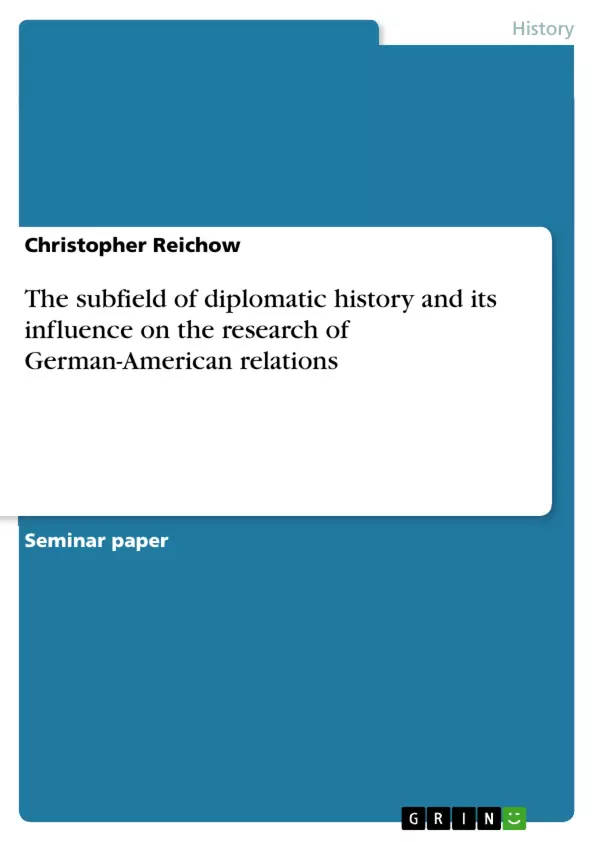Diplomatic history has been suffering an old-fashioned image within the historical science for a rather long time. Although there were no fewer conflicts in the world in the last decades, the attention of the historical profession to the research on official documents is quite low. As evidence of that, the number of diplomatic historians at most history departments around the world has shrunk continuously. Critics speak of outmoded methods, which are compared to new methods in modern subfields. It is their opinion that this subfield is unlikely to generate anything very creative.
In spite of this accusation, the subfield of diplomatic history has unambiguously changed its face in recent years. Diplomatic historians have widened their perspective and do not only analyze diplomacy anymore. They deal with a bulk of new topics: like race, gender, or approaches borrowed from cultural studies. Traditional approaches are still dominating the field, but new questions and new sources are increasingly used. Michael Hogan describes this development as a cultural turn. It is a wide-spread belief that the concept of diplomatic history has widened. Governments and diplomatic circles have to engage in a broader range of new issues. Thus, historical
Inhaltsverzeichnis (Table of Contents)
- Diplomatic History and Its Changing Face
- A Cultural Turn in Diplomatic History
- New Topics, New Approaches
- The Role of the Individual in Diplomatic History
- The Limits of Diplomatic History
- The World of Diplomacy
- Methodological Approaches in Diplomatic History
- Theoretical Frameworks in Diplomatic History
- German-American Relations: A Case Study
- Journals and Resources in International Relations
Zielsetzung und Themenschwerpunkte (Objectives and Key Themes)
This text examines the field of diplomatic history, exploring its evolution, key concepts, and its application to the study of German-American relations. The text aims to provide a comprehensive overview of the subfield, encompassing its historical development, methodological approaches, and theoretical frameworks. Key themes explored include:- The changing nature of diplomatic history and its expanding scope
- The influence of cultural and environmental factors on diplomatic relations
- The role of individuals and institutions in shaping diplomatic processes
- The importance of theoretical frameworks in understanding diplomatic history
- The historical development of German-American relations
Zusammenfassung der Kapitel (Chapter Summaries)
- The opening chapter discusses the evolution of diplomatic history, highlighting its shifting emphasis from state-centric to more inclusive perspectives.
- Chapter two examines the concept of a "cultural turn" in diplomatic history, exploring how new themes like gender, race, and environmental issues have become increasingly important.
- The third chapter delves into the changing nature of diplomatic relations, exploring how factors like globalization, cultural exchange, and environmental diplomacy have influenced state interactions.
- Chapter four discusses the role of individuals in shaping diplomatic history, emphasizing the significance of biographical studies and the influence of key figures.
- The fifth chapter delves into the limitations of diplomatic history, emphasizing the need to consider broader cultural, social, and economic contexts.
- Chapter six examines the evolving world of diplomacy, highlighting the rise of cultural diplomacy and its role in an increasingly interconnected world.
- The seventh chapter focuses on methodological approaches used in diplomatic history, exploring the interplay of human agency and structural forces in shaping historical processes.
- Chapter eight discusses the importance of theoretical frameworks in understanding diplomatic history, highlighting the role of political science theories in providing guidance and shaping research questions.
- The ninth chapter examines the historical development of German-American relations, using specific case studies to illustrate key themes and turning points.
- The final chapter briefly discusses the limited number of historical journals dedicated to international relations, highlighting the specific resources available for research on German-American relations.
Schlüsselwörter (Keywords)
The primary focus of this text lies in the subfield of diplomatic history. Key terms and concepts explored include: cultural turn, globalization, intercultural relations, environmental diplomacy, nation-centric approaches, state actors, individual influence, theoretical frameworks, realism, neo-realism, constructivism, deterrence theory, German-American relations, transatlantic images and perceptions, political, economic, and cultural influence, and historical journals in international relations.- Arbeit zitieren
- Bachelor of Arts Christopher Reichow (Autor:in), 2010, The subfield of diplomatic history and its influence on the research of German-American relations, München, GRIN Verlag, https://www.grin.com/document/179625



